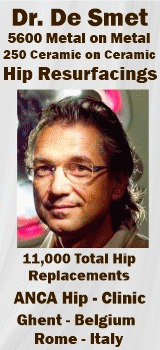Here is one of the few published studies that goes directly to your question. Worth noting that one of the Doctors involved in the study was Dr Harlan Amstutz, who first started working on resurfacing back in the 1970s, and is often thought of as one of the forefathers of modern resurfacing.
Presentation Abstract
Session: 15-Adult Reconstruction Hip II
Date/Time: Wednesday, Feb 08, 2012, 11:06 AM -11:12 AM
Presentation Number: 216
Title: The Relationship of Sporting Activity and Survivorship after Hip Resurfacing
Classification: Adult Reconstruction Hip
Keywords: Outcomes; Complications; Hip
Author(s): Harlan C. Amstutz, MD, Pacific Palisades, California, United States
Michel J. Le Duff, Glendale, California, United States
Regina Woon, Los Angeles, California, United States
Alicia J. Johnson, BA, Los Angeles, California, United States
Abstract: INTRODUCTIONThe effect of sports on the durability of the prosthesis after hip resurfacing has not yet been studied. This study correlates sporting activity levels computed as impact and cycle scores (ICS) with the survivorship of the procedure.
METHODSA total of 445 patients filled out a sport-specific survey between one and five years after surgery and were then followed clinically for a mean of 10 years. The mean age of the patients was 48.7 years and 74% were male. The ICS included two scores: an Impact Score (IS) and a Hip Cycle Score (HCS). All patients were also evaluated with the UCLA activity score. Twenty-three patients (27 hips) underwent revision surgery after filling out the survey.
RESULTSThe mean time of follow up at the time of survey data collection was 1.8 years (1.0 to 4.9) and the mean time of the follow-up period was 10.1 years (6.1 to 13.7). The mean IS was 28.1 (0 to 128) and the mean HCS 33.1 (0 to 144). Positive correlations were found between UCLA activity score and IS (r=0.535) or HCS (r=0.497). After adjustment for femoral component size, body mass index (BMI) and femoral defect size, a 10-point increment in IS corresponded to a 37% (95% CI 1.18 to 1.59) increase in the risk of revision while a 10-point increment in HCS increased the risk of revision by 22% (95% CI 1.06 to 1.41). Patients with an IS less than 50 had a risk of revision 3.8 times (95% CI 1.6 to 8.9) lower than the patients with an IS of 50 or greater, with a survivorship rate at eight years of 96.4% (95% CI 93.6% to 98.0%) vs. 88.8% (95% CI 74.7% to 95.3%). No association was found between UCLA activity score and survivorship of the procedure.
DISCUSSION AND CONCLUSIONHigh levels of sporting activities can be detrimental to the long-term success of hip resurfacing arthroplasty, independently from other risk factors. Patients seeking hip resurfacing are usually young and should limit their involvement in sports to levels that the construct will be able to sustain.











